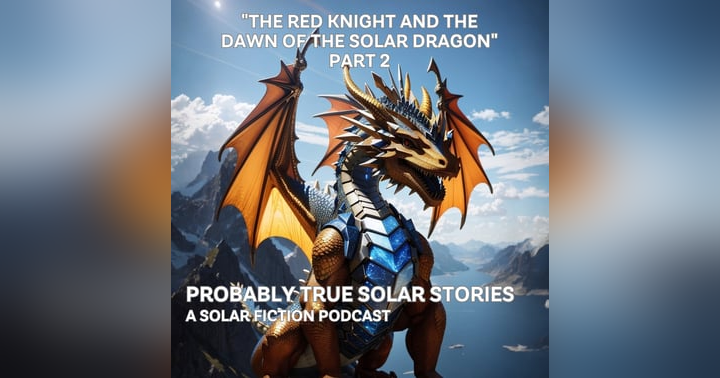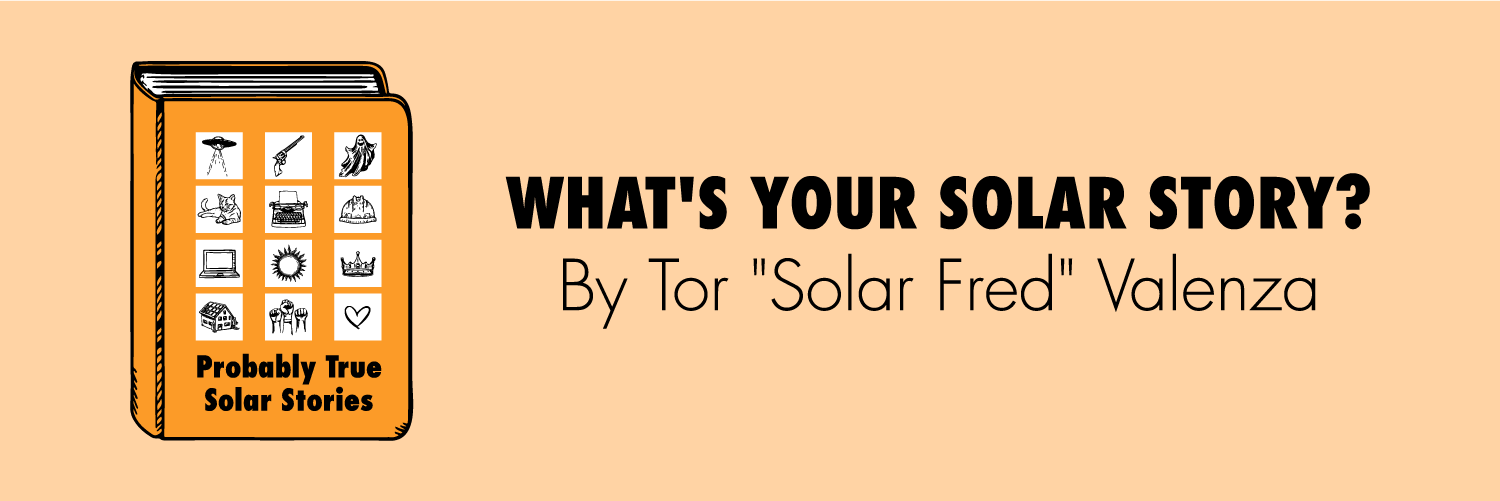Why Is Solar Missing in Film and TV Today?

Image credit: stock image modified by the author.
By Tor “Solar Fred” Valenza (originally published in Solar Today Magazine.)
Think about the last time you saw solar energy in a fictional film or television show. Keep thinking. I’ll wait.
If you’re finding it difficult, there’s a brief list below, but your difficult search is not surprising. Despite having over 4 million solar photovoltaic installations and 265,00 solar workers in the United States alone1 right now, solar is nearly invisible in film and television today.
Pop culture obscurity is a problem for accelerating solar adoption and solar career development and building support for solar policies and incentives. The more people see solar in everyday lives of fictional characters in films, TV shows, video games, songs and art, the more they’ll see solar as being a part of their own everyday lives and careers and policy priorities.
A Brief History of Solar in Film and TV
As for solar’s past starring roles in film and TV, on the surface, it looks good. According to Amazon’s Internet Movie Database (IMDb), there are 111 movies or TV series that mention solar panels. But this list clearly has database errors. Some don’t have any relation to solar or are parts of documentaries.2 Even when solar plays a part, it’s often portrayed inaccurately or as an element in a far-off science fiction fantasy.
At the top of the “what were they thinking?” list is “Sahara,” a movie that includes a ridiculous fight scene at a realistic-looking concentrated solar power (CSP) plant. Looks aside, most of what’s explained about the solar plant is inaccurate, especially the idea that it could leak toxic waste into water systems — a potential for nuclear plants,3 but not solar.
Even if all of this movie’s CSP information were accurate, CSP is not the kind of photovoltaic solar panels that consumers will see at today’s utility solar farms or on homes.
“The Man with the Golden Gun” also depicts a version of CSP, but once again, it’s a science fiction version that can not only solve the early 1970s oil crisis, but can also be used as a powerful laser weapon when placed in the hands of a supervillain. Zap! Zap! Take that!
All of that misinformation is fun for a James Bond movie, but it creates a bad impression of solar power and is far removed from the real lives of solar consumers and today’s solar workers.
On a positive solar fiction note, solar plays a fairly accurate life-saving sci-fi role in “The Martian.” Matt Damon plays an astronaut stranded on Mars who uses the station’s solar panels to survive while awaiting rescue. But, once again, it’s sci-fi, not set in today’s world or technology.
There are a few other examples. “Nim’s Island” shows characters using an off-grid solar and lead-acid battery system that today’s consumers would probably never purchase for their grid-tied homes.
Off-grid solar also often plays minor parts in apocalyptic TV series, like “The Walking Dead,” but it’s barely relevant to plots or characters beyond the obvious need of having electricity after the zombie apocalypse.
If solar is going to become globally mainstream, then consumers — especially those who vote — will need to see accurate, relevant portrayals of solar PV in the everyday lives and careers of fictional characters on film and TV. Playing a background part would be better than being invisible, but those visuals won’t accelerate our transition without solar playing a starring role.
Why Has Hollywood Ignored Solar?
I can’t tell you why Hollywood is ignoring solar’s current real-life success. Right now, scriptwriters are struggling to include plots about climate change. Solar is part of Apple TV’s “Extrapolations,” but it’s another science fiction doom-and-gloom soap opera set in the future.
I don’t think climate-fear plots inspire anyone to go solar or see themselves as a current solar worker or solar consumer. They just inspire them to switch the channel.
Instead of climate fear stories, Hollywood should put climate change in the background and instead develop contemporary stories around the solar and clean energy solutions that we have today.
Perhaps they still don’t see how to integrate solar, so I’ve offered some examples with my podcast “Probably True Solar Stories.”
I don’t run a film studio, but I am a former film and television writer who worked on “Stargate SG-1,” “Dharma & Greg,” and “The Dead Zone” and a solar communications pro at my public relations firm UnThink Solar. With an inexpensive podcast, I want to show how solar stories can be just as exciting, funny and dramatic as any show on Netflix or the networks.
With 25 short solar stories and growing, we show in each episode how solar can play a starring role in our most common pop culture genres. Because our culture seems to like dark action stories, instead of “film noir,” I’ve written “solar noir” episodes. For example, the podcast includes:
- “The Solar Heist, Or How I Got into the Solar Business,” an episode about a utility solar developer who has his solar modules confiscated by customs and partners with a thief to retrieve them
- “Murder by Solar Drone,” a mystery involving a solar installer who may or may not have witnessed a murder while doing a solar-drone site survey
- “The Caveman, The Devil’s Tools, and the Grid,” an action story about two teens who defeat a grid terrorist by using their parent’s EV and a solar smart home
Hollywood can just as easily create family-friendly solar stories. Here are some more examples from “Probably True Solar Stories:”
- “How Winnie the Pooh Went Solar (And Found More ‘Hunny’),” a children’s story that tells the process of going solar through Winnie-the-Pooh and his friends
- “We Didn’t Know Our Solar Home Was Haunted Until We Got a Text from the Ghost,” about a family’s new solar home that’s haunted by a mostly friendly ghost
- “The Red Knight and the Dawn of the Solar Dragon,” a darkly funny dragon story about a modern fairytale kingdom that’s in the middle of a difficult energy transition
Keep in mind that these stories aren’t written to be a technical solar or energy storage manual, although every episode’s show notes include “True Solar Takeaways” that separate each story’s solar facts from solar fiction.
Solar intentionally is very much a part of these plots and characters, just as the oil industry is part of the television show “Dallas” and doctors are a part of “Grey’s Anatomy.”
Regardless of the industry, good stories are about people and characters with exciting, dramatic or humorous challenges. Solar stories just happen to be set in the solar industry or around people who’ve gone solar. The more we see these stories, the more normalized solar becomes.
Why It’s Important for Solar to Be in Film, Television and Pop Culture
Surely, the solar industry will survive without being in popular culture, just as many professions and industries have survived without Hollywood’s attention.
But I think Hollywood’s attention may help us all survive the worsening effects of climate change by accelerating clean energy adoption to meet our global climate goals.
That means inspiring people and policymakers to care about implementing the solutions that we already have. Nonfiction case studies and examples in the news are two inspiration tactics, but these stories are rarely emotional, exciting or inspiring. People won’t talk about them at the proverbial watercooler, but they’ll often discuss the latest episodes of their favorite shows.
History Shows Us the Way: Automobile and Cellphone Adoption
“Did you see Barbenheimer?” Since the “Barbie” movie’s debut, Barbie doll sales are up by 25 percent.4 Although public opinion polls have not been done after the movie to measure its results, “Oppenheimer” has energized (pun intended) my pro-nuclear friends who are excited that nuclear energy is getting the Hollywood treatment in a mostly positive light.
Would having blockbuster solar movies or TV shows accelerate solar adoption, transfer careers to renewables, and support solar policies? History indicates that it could.
Like solar, early cars and cell phones were too expensive for most consumers. Then Ford Motor Company mass-produced the Model T and cell phone manufacturers and service providers brought the cost within reach of most consumers.
Of course, advertising was used to spread the word for both technologies. But films also played a role. If you look at Charlie Chaplin films, Harold Lloyd and other silent films of the early 1900s, many involved the challenges of owning and driving a car.
Check out Charlie Chaplin’s 1914’s “Mabel at the Wheel.”5 This silent film stars Mabel Normand as an independent woman interested in car racing and race car drivers. Chaplin plays a motorcyclist who tries to win her over. The film is the 1900s equivalent of “The Fast and Furious” car-culture media we have today. There are impressive stunts, breakdowns and quick fixes.
These early car movies show that the technology isn’t perfect, but they sure were exciting — and liberating, especially for women who were still trying to convince legislators to pass the 19th Amendment — the women’s right to vote.
Cell phones also got a pop culture boost in the late 1990s. Like solar today, many considered cell phones a luxury, despite their low monthly prices and included free flip phones. Back then, I was just getting used to email and dial-up internet.
Price alone didn’t convince me to buy a cell phone, but then I saw Keanu Reeves navigating “The Matrix” with his flip phone. And I saw Tom Cruise’s Jerry McGuire yell “Show me the money!!!” into his tiny cell phone, begging Cuba Gooding, Jr. to sign with him.
As cell phones became more common on film and television, I had to wonder why I didn’t have one. Were they really too expensive and a luxury or a life necessity? It made me want to find out. I got a quote, signed up, and have had a cell phone ever since. Thanks, Keanu and Tom!
While these weren’t planned car or cell phone campaigns, pop culture advocacy campaigns aren’t a new tactic. In 2012, NPR shared how public health officials educated Hispanic populations about having healthier lifestyles through telenovelas.6
I know the above examples from cars and cell phones are anecdotal, but it makes sense that fictional media affects technology adoption. The more we see likable characters — and even villains — using new technologies, the more we become curious about those technologies. Then we try those technologies and create our personal stories about them.
If fictional stories weren’t effective promotion, advertisers wouldn’t be spending millions for product placements in films and TV shows. In fact, General Motors just announced that it made a deal with Netflix to put its electric cars into every contemporary Netflix production.7 So, the clean energy storytelling tide is turning, but solar is still missing its spotlight so far.
Ideally, as solar becomes more popular in fiction, film, video games and streaming stories, policymakers will realize that there is a real-life demand and expectation that everyone should have access to solar. Workers will want to join the clean energy evolution and the public will expect solar to be on the roof of every home and business.
Of course, true solar stories will always matter. But fictional stories may resonate even more, inspire action, and cast solar off the screen and onto more solar roofs, fields and carports.
Sources
- https://tinyurl.com/solar-installs-jobs
- https://tinyurl.com/1solarPV
- https://tinyurl.com/nuclearW1
- https://tinyurl.com/Barbie-Sales
- https://tinyurl.com/MabelAtTheWheel
- https://tinyurl.com/telenovelahealth
- https://tinyurl.com/NetflixEvs
Tor “Solar Fred” Valenza is an American Solar Energy Society member, a 14-year solar public relations professional at UnThink Solar PR, and the host and writer of the “Probably True Solar Stories” podcast.








